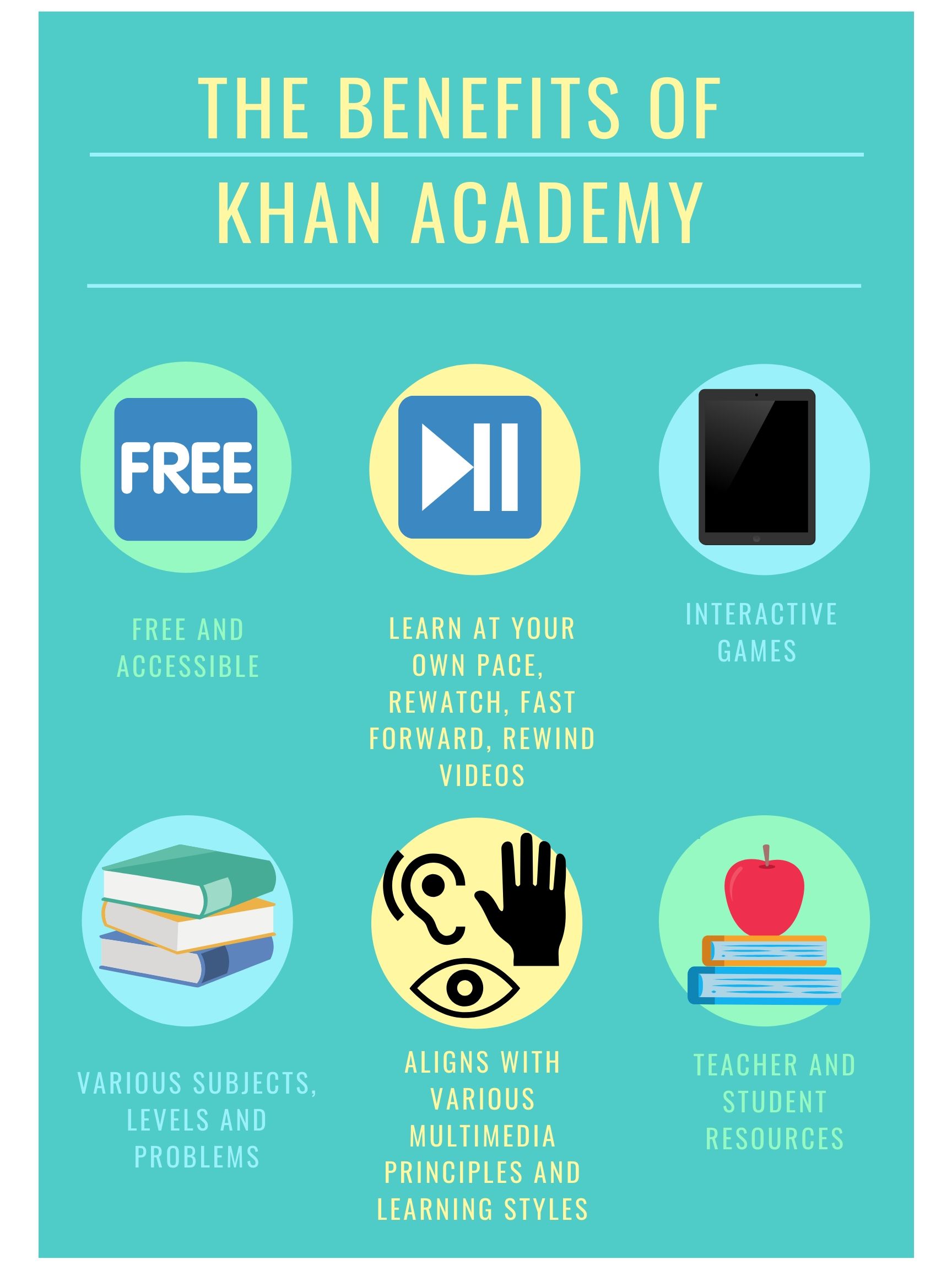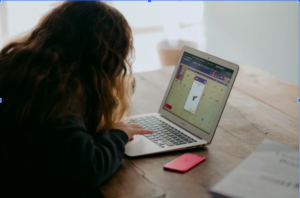
(Photo retrieved from: https://khankids.zendesk.com/hc/en-us/articles/360004559231-Welcome-to-Khan-Academy-Kids )
Introduction
Interactive multimedia applications are beneficial as they aim to support the diversity of student learners by promoting the use of various features. According to Arnold (2020), Khan Academy Kids increases literacy skills through its widely free and available surface. As such, Khan Academy Kids ties into numerous multimedia principles and demonstrates the use of various learning styles. Through its strengths, we will analyze the principles of multimedia, the pedagogy and the inclusion of diverse learners.

Photo created on Canva by Brittany
Principles of Multimedia
Khan Academy Kids utilizes the modality principle of narration and images to convey meaning and instruction. As Mayer (2014) states, “students learn better when the associated statements are narrated rather than presented visually”. This is especially vital for low-experienced learners who need extra assistance when learning meaning. By doing so, young students are able to better interpret the meaning of the material instead of experiencing cognitive overload with the inclusion of words on the screen. Additionally, the multimedia principle is evident throughout the app as the incorporation of both pictures and words allows young learners the ability to connect meaning to text. This is especially evident in the reading activities where young students are developing literacy skills. Fletcher & Tobias (2005) state that “words and images evoke different conceptual processes and that perception and learning are active, constructive processes”. Thus leading to the conclusion that Khan Academy Kids is developed in a way that promotes active learning and cognitive growth. In regards to classroom use of the application, the collaboration principle which states “people can learn better with collaborative online learning activities” (Mayer, 2014) demonstrates the benefit of learning with the addition of technology. Using this app as an extension to classroom learning will reinforce concepts and allow students to practice their learning at home with guidance.
The voice principle explains that people learn better when words are spoken in human voice, rather than machine or foreign-accented human voices (Mayer, 2014). Khan Academy Kids does not completely satisfy this principle, as a lot of the activities are spoken by a machine generated voice. That being said, the machine generated voice is presented by Kodi Bear, who is an on-screen agent and displays human-like movement and gestures, which satisfies the image principle (Mayer, 2014).
Khan Academy Kids’ Daily Circle Time (https://www.youtube.com/playlist?list=PLsO1jePSb_ql1hbBk81aZdg9TeED_LLcd) feature is put on by members of the Khan Academy Kids team and thereby exhibits the voice principle. It also demonstrates the worked-example principle, as their drawing activities include drawings done by other students. The worked example principle is also shown in their math activities, which can be beneficial for many students’ learning styles. Research has shown that when learning a new task, worked-examples are more efficient because it reduces the working load memory (Paas et al, 2004).
Pedagogy of Khan Academy
Khan Academy Kids goal is to “inspire lifelong learning” through fun activities that are widely available and academically engaging for all students (Khan Academy Launches New Educational Program For Children Ages Two To Five (2018, July 12)). Therefore, Khan uses content-centered video’s as it’s main form of pedagogy. This approach focuses on what the theme is, followed by the subject area and the aimed grade level (Di Blas et al., 2014). Through the application, students are able to use the features to best support their learning. According to Di Blas et al., (2014), another key pedagogy of Khan Academy Kids, is the Technology, Pedagogy and Content Knowledge (TPACK) model. This suggests that students use technology as a tool to understand the content, which helps teachers use this model to create a lesson plan that focuses on how to teach with technology. This is crucial as it recognizes the benefits of technology in the classroom. All in all, the TPACK model helps educators make purposeful lessons in accordance with technology.

Photo by Annie Sprat on Unsplash
Additionally, video-based learning follows a student centered approach. This tool acts as a means to provide children with the opportunity to have choice in their learning. It thus also allows the students to learn at their own pace as they are able to rewatch, rewind, fast forward. As a result we address the personal needs of each student through an inclusive design for learning.
Inclusion of Diverse Learners
One of the main benefits of Khan Academy Kids, for both teachers and students, is its ability to include diverse learners of many different abilities. An advantage that digital learning apps have over traditional methods of instruction is their greater ability to accommodate different learning styles and to consider prior student knowledge. While using Khan Academy Kids, the number of times the material is repeated, “the quantity and type of scaffold to aid learning, and the level of difficulty, can all be adjusted automatically based on the learner’s response” (Allen et al., 2016). Khan Academy Kids allows instructors to differentiate instruction with ease as the app enables students to learn and engage with the content at their own pace regardless of their grade level. One teacher in the United States who uses Khan Academy in her classroom regularly reported that the self-paced instruction that came with using the app allowed her to spend more time “working with individual students and less time on whole-class instruction” (Murphy et. al, 2014) something she preferred and believed benefited her students. This smooth transition can be critically important for language interventions for children with Autism Spectrum Disorder, where repeated exposure is required for learning (Allen et al., 2016). In addition, because of the app’s high engagement, it also supports learners with ADHD and ADD.
Based on the International Electronic Journal of Elementary Education’s App Checklist for Educators, we would rate Khan Academy Kids as a “five star” app because of its high student interest, design features, connections to the curriculum, and effective instructional features (Lubniewski & Mcarthur, 2018).
Conclusion
Overall, Khan Academy Kids acts as an interactive resource that aims to empower all learners. Khan Academy brings interactive and innovative ideas and resources through a free and accessible environment. Therefore these features allow children to learn by engaging with numerous multimedia principles and pedagogies in order to meet their individual learning styles and needs. As such, Khan Academy Kids fosters a fun interactive learning resource, which empowers them to be engaged through a student-centered approach. Thus, it provides them with the necessary tools to grow and further their knowledge and understanding.
Post by Amanda, Clara, Stephanie and Brittany
References
Allen, M. L., Hartley, C., & Cain, K. (2016). IPads and the Use of “Apps” by Children with Autism Spectrum Disorder: Do They Promote Learning? Frontiers in Psychology, 7. doi:10.3389/fpsyg.2016.01305
Arnold, D. (2020). New Educational App Shows Promise for Improving Pre-schoolers’ Pre-literacy Skills. Retrieved from: https://www.umass.edu/newsoffice/article/new-educational-app-shows-promise
Di Blas, N., Fiore, A., Mainetti, L., Vergallo, R., & Paolini, P. (2014). A portal of educational resources: Providing evidence for matching pedagogy with technology.Research in Learning Technology, 22, 1-26. doi:10.3402/rlt.v22.22906 https://journal.alt.ac.uk/index.php/rlt/article/view/1496/pdf_1
Fletcher, J. D., & Tobias, S. (2005). The Multimedia Principle. In R. E. Mayer (Ed.), The Cambridge handbook of multimedia learning (p. 117–133). Cambridge University Press. https://doi.org/10.1017/CBO9780511816819.008
Khan Academy Launches New Educational Program For Children Ages Two To Five. (2018, July 12). PR Newswire. Retrieved from https://link-gale-com.ezproxy.library.uvic.ca/apps/doc/A546317714/ITBC?u=uvictoria&sid=ITBC&xid=0a6b107f
Lubniewski, K. L., & Mcarthur, C. L. (2018). Evaluating Instructional Apps Using the App Checklist for Educators (ACE). International Electronic Journal of Elementary Education, 10(3), 323-329. doi:10.26822/iejee.2018336190
Murphy, R., Gallagher, L., Krumm, A ., Mislevy, J., & Hafter, A. (2014). Research on the Use of Khan Academy in Schools. Menlo Park, CA: SRI Education. https://s3.amazonaws.com/KA-share/impact/khan-academy-implementation-report-2014-04-15.pdf
Paas, F. Renkl, A., & Sweller, J. (2004). Cognitive Load Theory: Instructional Implications of the Interaction between Information Structures and Cognitive Architecture. Instructional Science, 32(1/2), 1-8. Retrieved from www.jstor.org/stable/41953634
Leave a Reply
You must be logged in to post a comment.